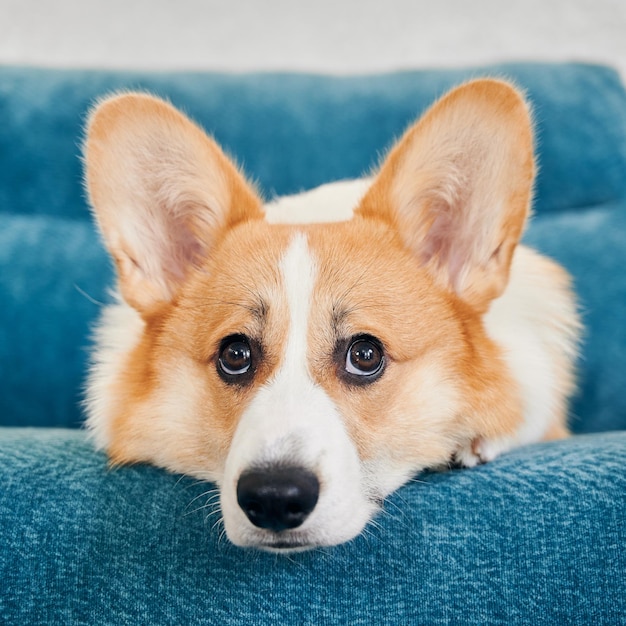In canine diversity, a captivating breed has been gaining steady attention and adoration among dog enthusiasts worldwide: the Doberman corgi mix, affectionately known as the door. This unique hybrid breed results from an intriguing combination of traits inherited from its distinguished parent breed, the Doberman pinscher and the Pembroke Welsh corgi.
| Breed Group: | Mix |
| Height: | 17-22 inches |
| Weight: | 35-60 pounds |
| Lifespan: | 10-13 years |
| Suitable for: | Active families, families with children, experienced dog owners |
| Temperament: | Intelligent, playful, affectionate, loyal, protective |
| Energy Level: | Medium-high |
Unfortunately, top kennel clubs like the American Kennel Club (AKC), Continental Kennel Club (CKC), and United Kennel Club (UKC) do not recognize Cowboy Corgis because they are a mixed breed.
Origin and History:
The Doborgi, a unique hybrid breed, owes its lineage to two distinct and beloved parent breeds: the Doberman Pinscher and the Pembroke Welsh Corgi. While these two breeds may seem like an unlikely pairing at first glance, the Doborgi has emerged as a delightful combination of their best qualities.
This unique combination aimed to cater to families looking for a loyal and affectionate companion with the potential for guarding and protective instincts.
While the Doborgi is not yet a widely recognized or standardized breed, its popularity has increased due to its distinctive characteristics and wonderful personality traits. Early instances of Doborgis were primarily the result of intentional breeding efforts by dedicated enthusiasts who saw the potential in this hybrid.

Physical Characteristics:
The Doborgi’s physical appearance is captivating, blending features from the Doberman and the Corgi. While individual Doborgis can vary in appearance, they often exhibit a harmonious mix of their parent breeds.
Size: Typically, Doborgis fall into the small to medium-sized category, inheriting the Corgi’s stature.
Coat colors may range from black and tan to red and sable, offering diverse options.
Color Variations: Doborgis can display a wide range of color combinations, often with striking markings. These markings can include a black mask around their face or white patches on their chest and paws.
The overall effect of these physical traits is a charming and distinctive appearance that captures the attention of anyone lucky enough to meet a Doborgi. Their unique blend of features makes them not only adorable but also quite memorable.
Temperament and Behavior:
Doborgis, the charming blend of Doberman Pinscher and Pembroke Welsh Corgi, possess a temperament that combines the best of both parent breeds, resulting in a unique and delightful personality.
Intelligence: Doborgis are known for their high level of intelligence. This trait is inherited from the Doberman side of their lineage, a breed renowned for its quick learning and problem-solving abilities. This intelligence makes Doborgis highly trainable and eager to please their owners.
Loyalty: Loyalty is a cornerstone of the Doborgi’s temperament. They form strong bonds with their families and are often fiercely protective of their loved ones, taking after the Doberman’s protective instincts. This loyalty makes them excellent watchdogs, as they’ll alert you to any potential threats.
Family Interaction: Doborgis are affectionate and thrive on human interaction
Interaction with Other Pets: While Doborgis tend to get along well with other dogs and pets, early socialization is key to ensure harmonious relationships. Their herding instincts from the Corgi side may lead them to try to “herd” smaller pets, so it’s essential to monitor their interactions and provide proper training and socialization from a young age.
Exercise and Training Needs:
Doborgis are energetic and intelligent dogs, and meeting their exercise and training needs is crucial for their physical and mental well-being.
Exercise Requirements: Doborgis need a fair amount of exercise to keep them happy and healthy. Aim for at least 45-60 minutes of daily physical activity. This can include brisk walks, playtime in a secure yard, or interactive games like fetch and agility. Without sufficient exercise, they may become restless and may develop behavioral issues.
Training Tips: Training your Doborgi should start early and be based on positive reinforcement methods. They are eager to learn and respond well to consistent, reward-based training. Obedience training is essential to ensure they grow up to be well-behaved adults.
Importance of Early Socialization: Early socialization is critical to a Doborgi’s development. It helps them become well-rounded and confident dogs, comfortable with various people, animals, and situations. Enrolling in puppy socialization classes is an excellent way to kickstart this process.
Behavioural Challenges: Like all dogs, Doborgis may exhibit occasional stubbornness or independence, particularly if they sense inconsistency in training. Patience and positive reinforcement will go a long way in addressing any training challenges.
Exercise and Training Needs:
Doborgis are a blend of two active breeds, the Doberman Pinscher and the Pembroke Welsh Corgi, which means they have energy to spare. To keep your Doborgi happy and well-behaved, it’s essential to meet their exercise requirements.
Exercise Requirements: Doborgis thrive with daily exercise, including brisk walks, playtime in a secure yard, and mentally stimulating activities. Aim for at least 45-60 minutes of physical activity each day to prevent boredom and potential behavior problems.
Training Tips: Training your Doborgi should start early, ideally when they are still puppies. They are intelligent dogs and tend to respond well to positive reinforcement techniques. Consistency and patience are key to successful training. Socialization is equally important, as it helps them become well-rounded and confident adults. Expose your Doborgi to various people, animals, and environments to build their social skills.
Importance of Socialization: Early socialization ensures your Doborgi grows up to be a well-adjusted and friendly dog. It helps them learn how to interact with other dogs, humans, and different situations. Enrolling in puppy socialization classes can be an excellent way to start this process.
Health Considerations:
Doborgis may inherit certain health concerns from their parent breeds, and responsible ownership involves being aware of these potential issues. While not all Doborgis will experience these problems, it’s crucial to stay vigilant and address any health concerns promptly.
Potential Health Issues: Some of the health conditions that Doborgis may be prone to include hip dysplasia, degenerative myelopathy, Von Willebrand’s disease (a bleeding disorder), and back issues. Regular check-ups with a veterinarian can help monitor your Doborgi’s health and catch any issues early.
Preventive Measures: Maintaining a healthy weight, providing regular exercise, and feeding a balanced diet can help prevent obesity and some health problems. Since both parent breeds may have certain genetic predispositions, it’s essential to obtain your Doborgi from a reputable breeder who conducts health screenings on their breeding dogs.

Grooming and Maintenance:
Grooming your Doborgi plays a crucial role in keeping them comfortable and healthy. Here are some grooming tips for Doborgi owners:
Brushing: Depending on their coat type, Doborgis may require regular brushing to control shedding and prevent matting. Short-haired Doborgis may need brushing once a week, while those with longer, double coats may benefit from more frequent brushing, especially during shedding seasons.
Bathing: Bathe your Doborgi as needed, typically every 6-8 weeks or when they get dirty. Use a gentle dog shampoo to avoid skin irritation. Be sure to dry them thoroughly after bathing to prevent skin issues.
Nail Trimming: Regularly trim your Doborgi’s nails to prevent overgrowth, which can be uncomfortable and affect their gait. If you’re unsure about nail trimming, ask your vet or a professional groomer for guidance.
Coat Care: Be attentive to their unique coat requirements. Doborgis with short coats are less likely to tangle or mat, while those with longer, double coats may require more attention to prevent matting.
Living Arrangements:
Doborgis can adapt to various living situations, but their energy levels and exercise needs should be considered.
Apartments: Doborgis can thrive in apartments if they receive adequate exercise and mental stimulation. Daily walks and playtime are essential to keep them happy and prevent boredom-related behaviors.
Houses with Yards: A house with a yard is ideal for Doborgis, as it provides space for them to run and play. However, even in a yard, they need regular exercise and interaction with their owners.
Doborgi Energy Levels: While they are smaller than purebred Dobermans, Doborgis still have a good amount of energy. They enjoy outdoor activities like fetch and agility training. Ensure they have opportunities to burn off energy to prevent restlessness.

Conclusion:
In conclusion, Doborgis are a wonderful blend of two distinct breeds, offering a unique combination of physical traits and personality characteristics. With proper exercise, training, grooming, and attention to health, Doborgi owners can enjoy the companionship of a loving and loyal canine companion in various living environments.
These are other Doberman mix Breeds:





